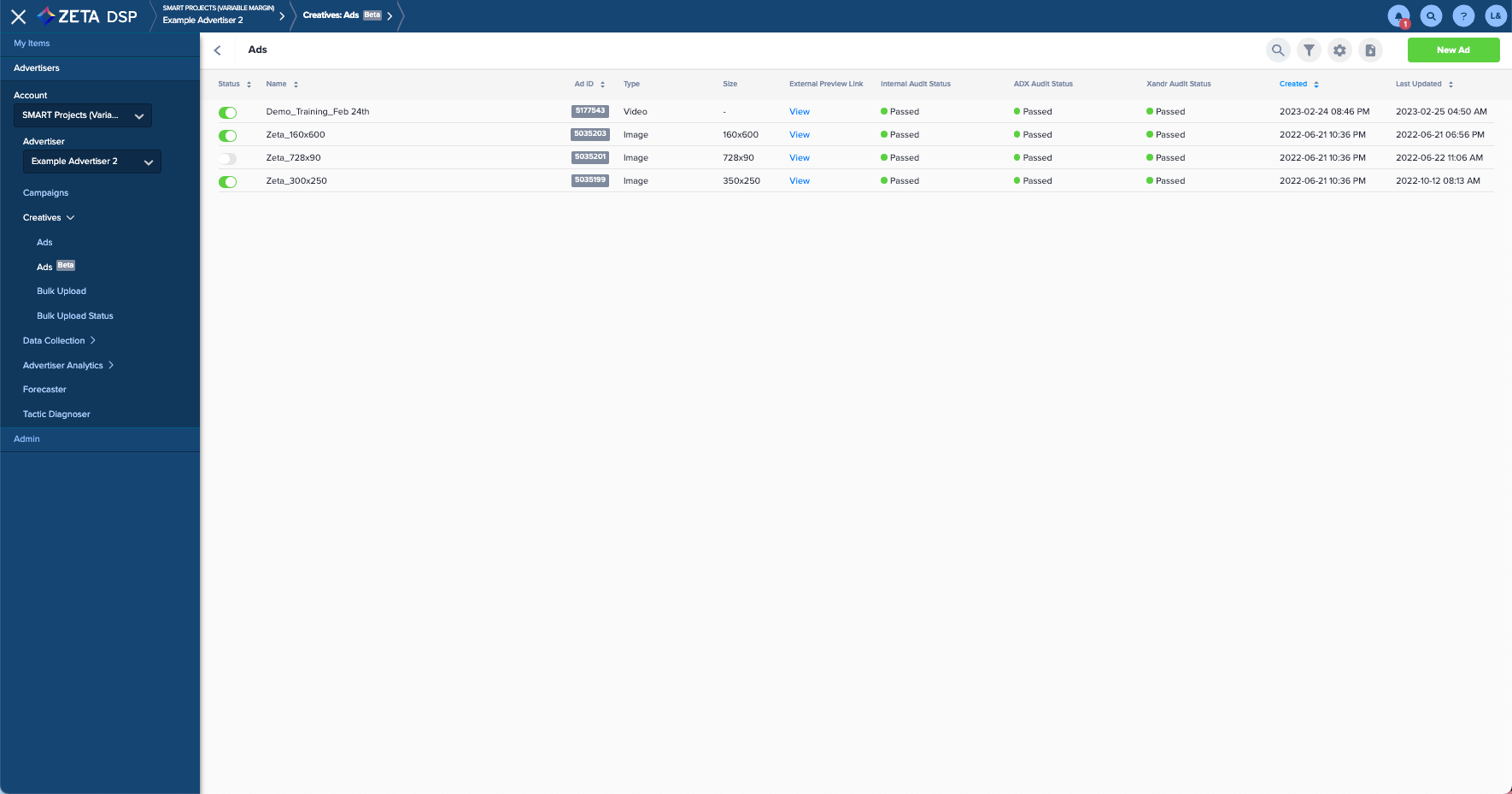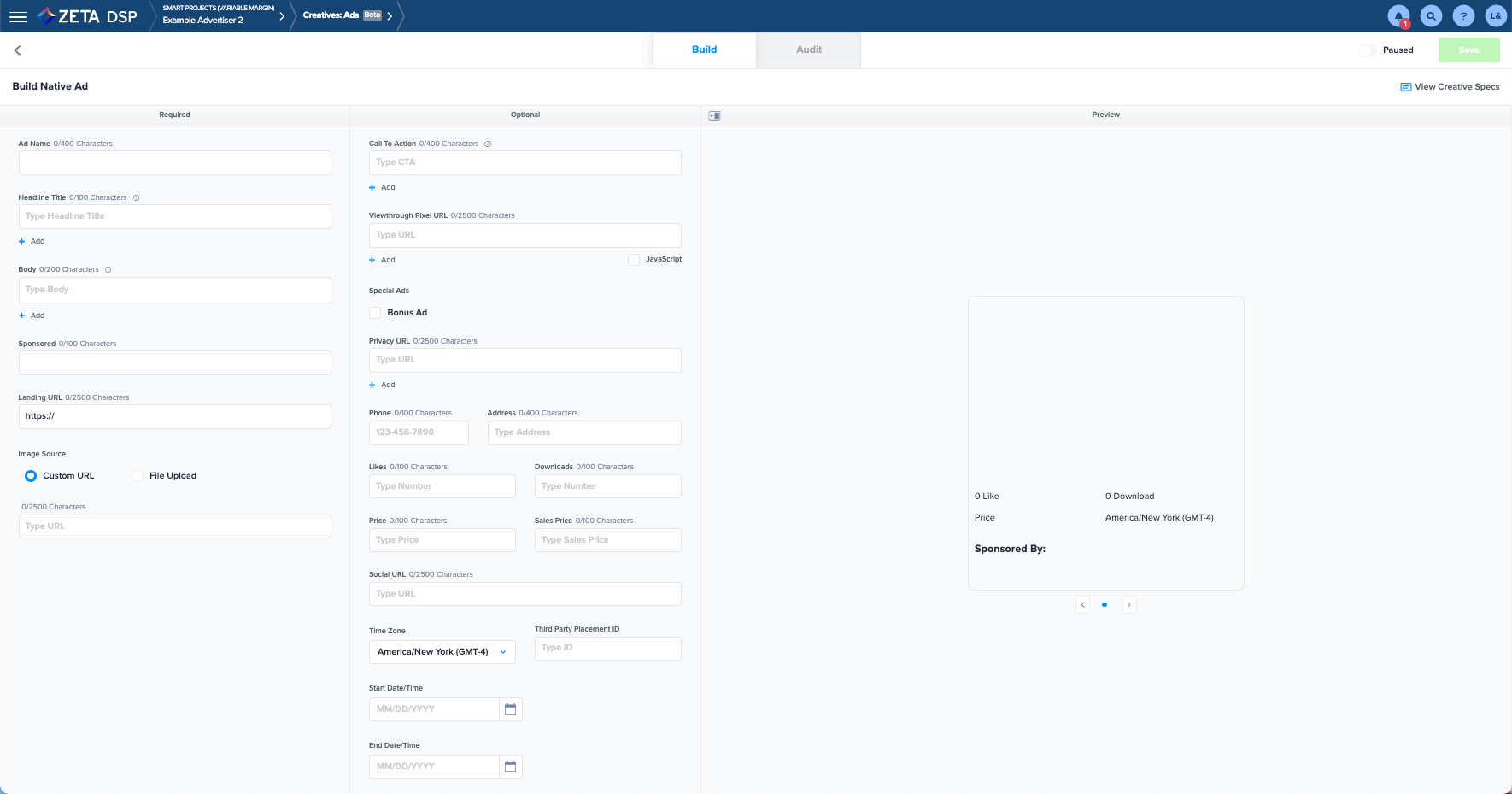Native Ads

Zeta's Native Advertising offering gives you the ability to deliver editorial-style Ads that complement the user experience in which they are placed.
These Ads help drive maximum ROI for marketers by leveraging Zeta's industry-leading Moment Scoring technology to serve ads to the right users, in the right sections of a publisher's website leading to high user engagement.
Native Advertising is supported by any campaign that is being executed through the Zeta DSP such as retargeting, direct response, prospecting, and brand campaigns.
Native Ads are always going to meet the editorial standards for a publisher.
They also provide a different experience than a typical banner.
How is Native Advertising Different than Banner Advertising?
Native Advertising drives better performance (clicks, conversions, user engagement) because Native Ads look a lot like content and, therefore, make it easy for an audience to engage with.
Native Ads have a flexible ad size and thus are able to easily blend into surrounding platforms.
Native Ads drive better user experience through their editorial-like ads. This leads to an overall brand lift.
Native Advertising gives access to more inventory for marketers. The overall publisher Inventory is on the rise as more publishers convert their inventory to native.
Increased Viewability (Third-Party measurement capability is unknown)
Native Ad Types
Native Ads can be of many types:
Recommendation Widgets
Promoted Listings
In-Feed Units
Recommendation Widget and In-Feed Unit are the Native Ad formats we offer at the moment. The other Native Ad types will become available as we continue building the product.
Creating New Native Ads
1. Once you’ve selected the Account and your Advertiser, navigate to Creatives > Ads within the menu on the left.

2. Within the Ads screen, click on New Ad and choose Native from the drop-down.

3. Set values for this Ad Type within the Ad Builder as per the table below.

Native Ad Creation Fields
Field | Description |
Ad Name (Required) | It is best practice to include the following in this field:
Example: 170617-ImproveAnimalAdoption-Native (Tablet) |
Headline Title (Required) | The recommended length is 30 characters min, 60 characters max. How to write an effective Native Headline title:
Example: Adopt! Don't Shop! |
Body (Required) | Description of the Ad. The recommended length is 90 characters min, 125 characters max. Example: Adopt your best friend today! |
Sponsored (Required) | This is typically the name of the Advertiser. Example: Bay Area Animal Shelter |
Landing URL (Required) | Enter the URL of the page to which the ad clicks through. Macros are not automatically inserted when click-through trackers are used for this field. Please reach out to Zeta Support if any assistance is needed for applying macros to the additional trackers. The maximum allowed length is 1024 characters. |
Image Source (Required) | Supply an image file for your Ad. Min pixel size is 500 X 500, however, 1200 X 672 is recommended with roughly 2:1 aspect ratio (free of text). Supported file types (less than 1 MB):
Choose File Upload to upload the image from your computer. Choose URL to enter the URL where the DSP can find the image on the World Wide Web. |
Call to Action (Optional) | Users' desired action. Example: Apply Now |
Viewthrough Pixel URL (Optional) | Enter text for a view tag. When someone views the Ad, a cookie with this tag is dropped on their computer. If the same person later converts, the conversion can be attributed to the view tag. |
Bonus Ad (Optional) | Check the box if the ad is “Bonus” |
Privacy URL (Optional) | |
Phone (Optional) | |
Address (Optional) | |
Likes (Optional) | |
Downloads (Optional) | |
Price (Optional) | |
Sales Price (Optional) | |
Social URL (Optional) | |
Time Zone (Optional) | Select the time zone that the Zeta use to run the Ad per the Start and End Times specified in the next two fields. |
Third-Party Placement ID (Optional) | Use this field to store on the Third Party Placement ID, and then report on this field using the Third Party Placement ID metric in the Report Builder. Third-Party Ad ID was a legacy metric that was automatically extracted from some DCM ad tags. In those cases, this field is automatically populated. You can overwrite this field as necessary. |
Start Date/Time (Optional) | Specify the beginning date and time during which the Ad is to be available to campaigns. If you leave it unspecified, the Ad is available immediately. |
End Date/Time (Optional) | Specify the end date and time during which the Ad is to be available to campaigns. If you leave it unspecified, the Ad inherits the run dates of its campaign. |
Best Practices |
|---|
Larger Images - Provide the largest image available to maximize the number of placements. Stretching small images to larger placements diminishes ad quality. Zeta supports image sizes up to 1MB, and will never stretch your images. |
Lifestyle Images Drive Stronger Performance - Use images that show your product in context. Lifestyle images outperform informational graphics and stand-alone product images. |
Minimize (or Eliminate) Text on Images - Text on images can get cut off when the images are dynamically resized and cropped to fit thousands of publisher placements. We recommend keeping images text free and limiting the text to the headline and body copy. If text is needed, please center it as much as possible leaving ample room on all 4 sides. |
Images Should Reflect Your Audience - Leverage images that reflect the target audience and their lifestyle. This helps keep creative relatable and engaging. |
Avoid Glamour Shots - For product-focused ads, images that depict the product in the context of everyday life outperform ads where a product is shown in isolation. |
Center the Focal Points - The focal point of the image should be as centered as possible. If there are multiple focal points, make sure there is ample spacing and the focal points are not at the edges of the image. This will ensure that key elements are not cropped out. |
Transparency and Clear Disclosure - Advertisers should be sure to include logo and the words "Sponsored Advertising Content" or "Sponsored By". This not only abides by FTC Guidance, but also gains trust with your audience. |
Integration with Client Content - To ensure the ad offers a truly native experience, it should match the look and feel of a site. Copy should match the font size, color, and style to flow seamlessly. |
Use Language that Resonates with your Audience - Headline and body copy should be clear, concise, and speak directly to your audience. Be sure to include a direct call to action. |
Use Short and Direct Copy - Copy should be able to stand on its own, form a cohesive message, as well as be relevant to the image. |
Deliver Value - Offer insightful messaging that resonates with consumers. Providing value to the consumer informing of how best to use the product can pay dividends on performance. |
Don't Over Target - Native ads are located within the flow of editorial content and are more likely to be seen. Ads that are contextually relevant drive higher CTR than ads that are behaviorally targeted. Native ads will be automatically served on exchanges that have native inventory; no extra targeting is required. |
Reward Engagement - Drive consumers to a landing page that is relevant to the ad. This helps to ensure the consumer knows why they landed on your site and prevents any feeling of deception. |
Placement Matters - Ads delivered in the stream of content (even the ones delivered below the fold) outperform the right rail placements. |
Optimize, Optimize, and Optimize - Whenever possible, use multiple images and optimize to the creative that performs the best. |
